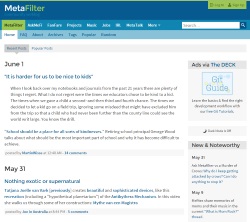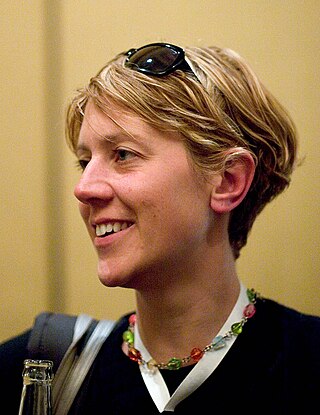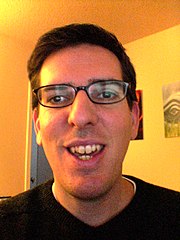
A blog is an informational website published on the World Wide Web consisting of discrete, often informal diary-style text entries (posts). Posts are typically displayed in reverse chronological order so that the most recent post appears first, at the top of the web page. Until 2009, blogs were usually the work of a single individual, occasionally of a small group, and often covered a single subject or topic. In the 2010s, "multi-author blogs" (MABs) emerged, featuring the writing of multiple authors and sometimes professionally edited. MABs from newspapers, other media outlets, universities, think tanks, advocacy groups, and similar institutions account for an increasing quantity of blog traffic. The rise of Twitter and other "microblogging" systems helps integrate MABs and single-author blogs into the news media. Blog can also be used as a verb, meaning to maintain or add content to a blog.

Jorn Barger is an American blogger, best known as editor of Robot Wisdom, an influential early weblog. Barger coined the term weblog to describe the process of "logging the web" as he surfed. He has also written extensively on James Joyce and artificial intelligence, among other subjects; his writing is almost entirely self-published.
The blogosphere is made up of all blogs and their interconnections. The term implies that blogs exist together as a connected community or as a social networking service in which everyday authors can publish their opinions.
A trackback allows one website to notify another about an update. It is one of four types of linkback methods for website authors to request notification when somebody links to one of their documents. This enables authors to keep track of who is linking to their articles. Some weblog software, such as SilverStripe, WordPress, Drupal, and Movable Type, supports automatic pingbacks where all the links in a published article can be pinged when the article is published. The term is used colloquially for any kind of linkback.

MetaFilter, known as MeFi to its members, is a general-interest community weblog, founded in 1999 and based in the United States, featuring links to content that users have discovered on the web. Since 2003, it has included the popular question-and-answer subsite Ask MetaFilter. The site has eight paid staff members as of December 2021, including the owner. MetaFilter has about 12,000 active members as of early 2011.

Meg Hourihan is the cofounder of Pyra Labs, the company that launched the Blogger personal blogging software that was acquired by Google.
A permalink or permanent link is a URL that is intended to remain unchanged for many years into the future, yielding a hyperlink that is less susceptible to link rot. Permalinks are often rendered simply, that is, as clean URLs, to be easier to type and remember. Most modern blogging and content-syndication software systems support such links. Sometimes URL shortening is used to create them.
Following a crackdown on Iranian media beginning in 2000, many Iranians turned to weblogging to provide and find political news. The first Persian language blog is thought to have been created by Hossein Derakhshan,, in 2001. Derakhshan also provided readers with a simple instruction manual in Persian on how to start a blog. In 2004, a census of blogs around the world by the NITLE found 64,000 Persian language blogs. In that year the Islamic government also began to arrest and charge bloggers as political dissidents and by 2005 dozens of bloggers had been arrested.

Jessamyn Charity West is an American library technologist and writer known for her activism and work on the digital divide. She is the creator of librarian.net. She is the Vermont Chapter Councilor of the American Library Association, and was Director of Operations at the massive group blog MetaFilter from 2005 to 2014. West owns MetaFilter.

Evan "Ev" Clark Williams is an American billionaire technology entrepreneur. He is a co-founder of Twitter, and was its CEO from 2008 to 2010, and a member of its board from 2007 to 2019. He founded Blogger and Medium, two of the largest blogging internet platforms. In 2014, he co-founded the venture capital firm Obvious Ventures. As of February 2022, his net worth is estimated at US$2.1 billion.
The Mormon blogosphere is a segment of the blogosphere focused on issues related to the Church of Jesus Christ of Latter-day Saints. The term "Bloggernacle" was coined by individuals within the Latter-day Saint blogging community as a play on the name of the Mormon Tabernacle Choir; however, not all Latter-day Saint-themed bloggers like or use the name Bloggernacle, or even consider their blog to be part of it. Furthermore, not all bloggers within the Mormon blogosphere are Latter-day Saints themselves.
In blogging, a ping is an XML-RPC-based push mechanism by which a weblog notifies a server that its content has been updated. An XML-RPC signal is sent from the weblog to one or more Ping servers, as specified by originating weblog), to notify a list of their "Services" of new content on the weblog.
This is a list of blogging terms. Blogging, like any hobby, has developed something of a specialized vocabulary. The following is an attempt to explain a few of the more common phrases and words, including etymologies when not obvious.

A photoblog is a form of photo sharing and publishing in the format of a blog. It differs from a blog through the predominant use of and focus on photographs rather than text. Photoblogging gained momentum in the early 2000s with the advent of the moblog and cameraphones.
nofollow is a setting on a web page hyperlink that directs search engines not to use the link for page ranking calculations. It is specified in the page as a type of link relation; that is: <a rel="nofollow" ...>. Because search engines often calculate a site's importance according to the number of hyperlinks from other sites, the nofollow setting allows website authors to indicate that the presence of a link is not an endorsement of the target site's importance.
An edublog is a blog created for educational purposes. Edublogs archive and support student and teacher learning by facilitating reflection, questioning by self and others, collaboration and by providing contexts for engaging in higher-order thinking. Edublogs proliferated when blogging architecture became more simplified and teachers perceived the instructional potential of blogs as an online resource. The use of blogs has become popular in education institutions including public schools and colleges. Blogs can be useful tools for sharing information and tips among co-workers, providing information for students, or keeping in contact with parents. Common examples include blogs written by or for teachers, blogs maintained for the purpose of classroom instruction, or blogs written about educational policy. Educators who blog are sometimes called edubloggers.

Darren Rowse is an Australian blogger, speaker, consultant and founder of several blogs and blog networks, including ProBlogger.net and digital-photography-school.com. He lives in Melbourne, Australia.
Mobile blogging is a method of publishing to a website or blog from a mobile phone or other handheld device. A moblog helps habitual bloggers to post write-ups directly from their phones even when on the move. Mobile blogging has been made possible by technological convergence, as bloggers have been able to write, record and upload different media all from a single, mobile device. At the height of its growth in 2006, mobile blogging experienced 70,000 blog creations a day and 29,100 blog posts an hour. Between 2006 and 2010, blogging among teens declined from 28% to 14%, while blogging among adults over 30 increased from 7% to 11%. However, the growing number of multi-platform blogging apps has increased mobile blogging popularity in recent years creating a brand new market that many celebrities, regular bloggers and specialists are utilizing to widen their social reach.
While the term "blog" was not coined until the late 1990s, the history of blogging starts with several digital precursors to it. Before "blogging" became popular, digital communities took many forms, including Usenet, commercial online services such as GEnie, BiX and the early CompuServe, e-mail lists and Bulletin Board Systems (BBS). In the 1990s, Internet forum software, such as WebEx, created running conversations with "threads". Threads are topical connections between messages on a metaphorical "corkboard". Some have likened blogging to the Mass-Observation project of the mid-20th century.
The Weblog Awards, nicknamed the Bloggies, was an annual non-profit blog awards that began in 2001. Until its end in 2015, it was the longest running and one of the largest blog awards, with winners determined through internet voting by the public. The Weblog Awards were presented by Nikolai Nolan, and was covered by many major news organizations.








